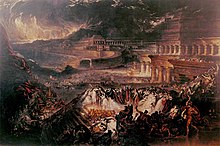|
The Fall of Nineveh
 The Fall of Nineveh is a long poem in blank verse by Edwin Atherstone.[1] It consists of thirty books preceded by a Prelude. The poem was written over many years and published 1828–1868. It tells of the battles and events during the war between the coalition of Medes and Babylonians against the Assyrians. PlotThe main heroes are Sardanapalus, King of Nineveh and of all the Assyrian Empire; Arbaces, the prince of Medes; and a Babylonian priest, Belesis. Sardanapalus is portrayed as a womanizer, coward, and cruel tyrant. When defeated by Arbaces he burns his own palace with all his concubines inside and dies in the fire. All Nineveh is destroyed. ExcerptThe poem can be interpreted as praise of modern democracy. It begins: Of Nineveh the mighty city of old, Notes
References
|
Portal di Ensiklopedia Dunia